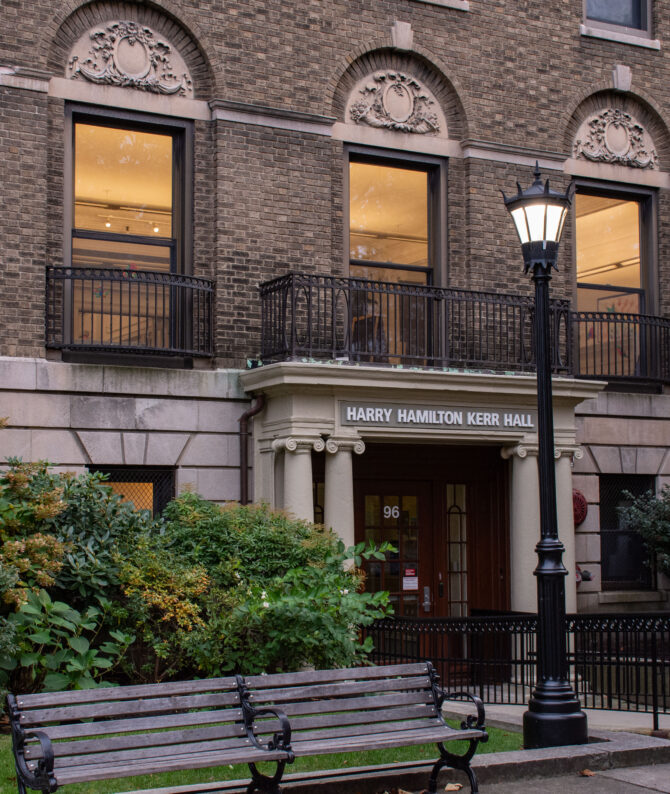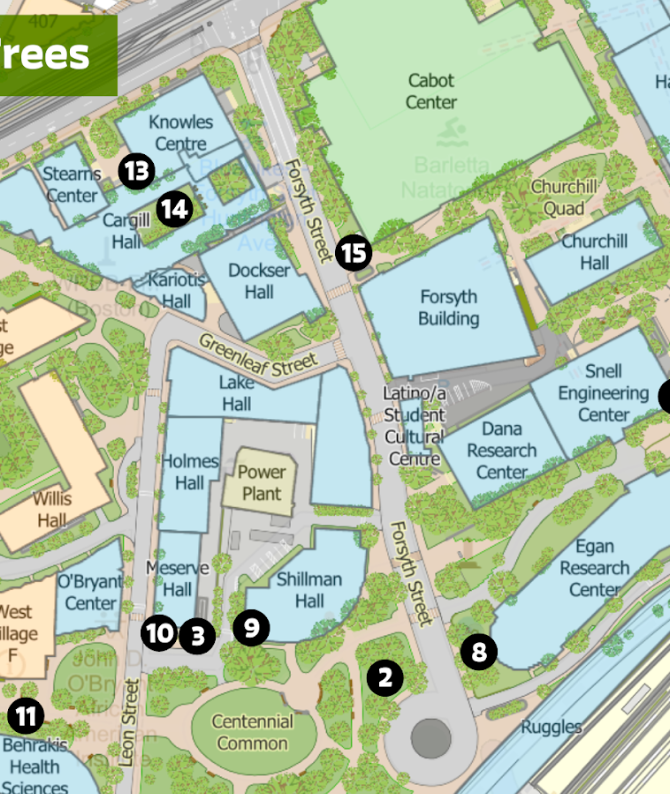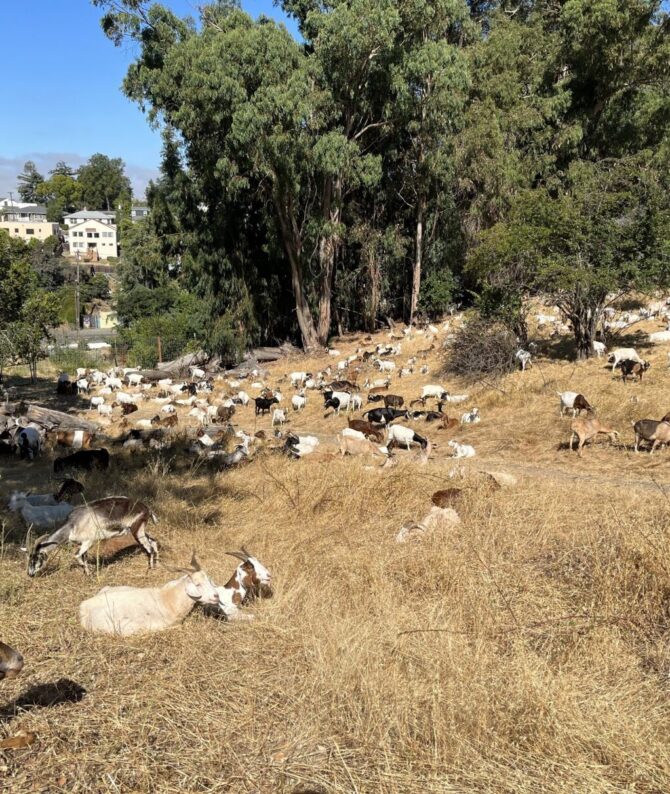All in a Day’s Work: Life as an Arboretum Co-Op

There’s never a dull moment while working at the Northeastern Arboretum. After meeting with current co-ops Alegra Germain and Grace Arents, along with former co-op/current Arboretum assistant Indira Holdsworth, it becomes clear that this small but essential team plays an integral role in not just the day-to-day maintenance of the Arboretum, but also in educating and engaging communities to inspire climate action.
“I get this question a lot and I like to preface it with the fact that no day looks the same,” says Germain, after being asked to describe a typical day on the job. “Working at the Arboretum [is] a fun surprise. Every day we come in and it’s different.”
| The Arboretum team consists of just four individuals. Germain, Arents, and Holdsworth report to Steve Schneider, the chief arborist at Northeastern University. Though their team is relatively small, their work has wide-ranging impacts on the campus community.
One of Germain, Arents, and Holdsworth’s primary responsibilities is maintaining the Arboretum’s records. “That can be anything from updating the locations of different plantings around campus, to swapping out tags, to adding new plantings,” says Germain. “Yesterday, we spent the entire day together replacing tags and labels and updating our system.” The recent focus on tag replacements is part of the Arboretum’s updates to their accession system, labeling each plant with a unique accession number to keep track of important planting information within an online database. |
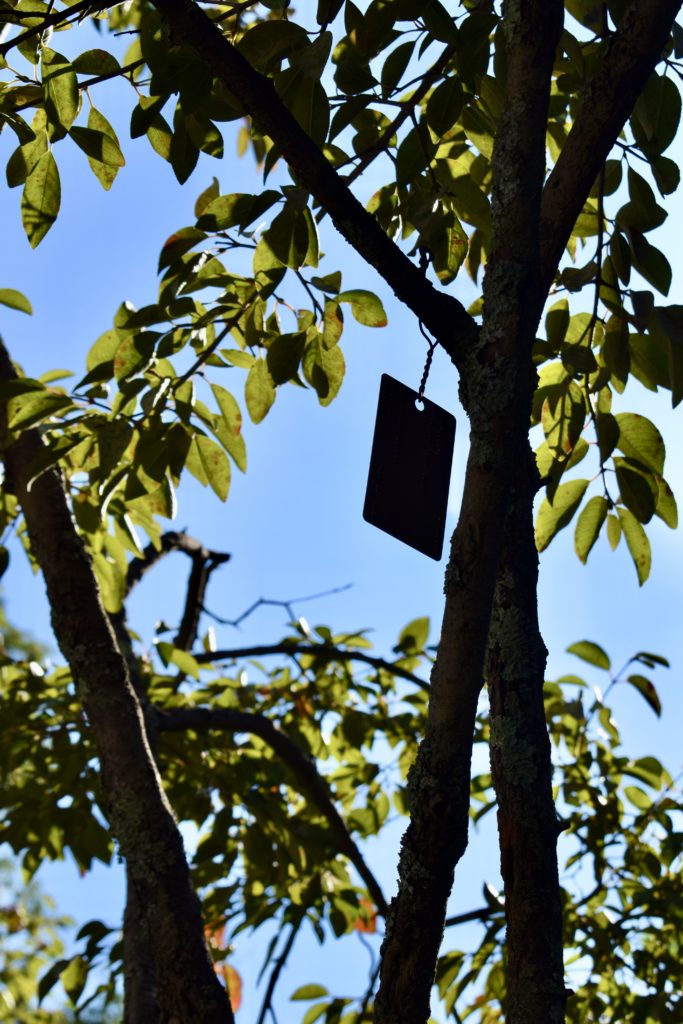 Photo by Alegra Germaine, 2022. |
Arents is also using the software tool i-Tree to record information about trees within the Arboretum, including height, width, species, and distance from buildings. This data can be used by i-Tree to generate an approximation of a tree’s “value”. Arents explains, i-Tree “help[s] us monetize the value of a single tree but also a group of trees like the Arboretum… We could [give this information] to Northeastern and say, ‘Don’t take out this tree. It’s worth this much over the next 30 years.’”
The students also spearhead a variety of community outreach and education initiatives. They can frequently be found tabling at events on campus or in the community, leading Arboretum tours, or featuring their work on the Arboretum’s Instagram account.

In their experiences talking with members of the Northeastern community, the team has noticed a particular trend: “A lot of students don’t actually know that we’re a certified Arboretum,” says Arents. But, Germain adds, “when they hear that we are, that’s very exciting, and that prompts people to ask a lot more questions.”
The Northeastern Arboretum is home to over 160 tree species. These greenspaces provide a wide range of ecosystem services.
Tree cover provided within the Arboretum helps to cool surrounding areas, mitigating the urban heat island effect. The trees also help to reduce potential stormwater runoff and flooding in urban spaces by increasing the storage and infiltration capacities of the soil, allowing water to be absorbed instead of accumulating on impermeable surfaces like pavement.
Plants are also beneficial for improving air quality, reducing city noise, and improving mental health.
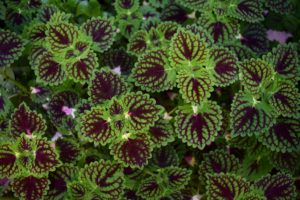 Photo by Alegra Germaine, 2022. |
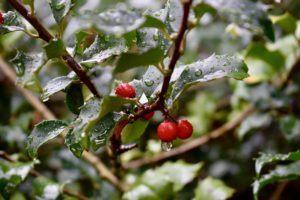 Photo by Alegra Germaine, 2022. |
Germain finds that one of the most effective ways to engage audiences in discussions about the Arboretum’s benefits is “just making things relatable” to people’s own lived experiences.
“We have this beautiful greenspace that for aesthetic reasons obviously is very important,” says Germain. “But for every other reason, you [should] know why this greenspace is so important. When you’re on Northeastern campus, it is going to be significantly cooler than the rest of Boston because we have these trees… protecting us and helping us combat the urban heat island effect. Campus isn’t going to be flooding as it [might otherwise be] because we have this extra layer of trees and soil.”
Social media has also provided the Arboretum team with new avenues for educating their followers. Germain, who is responsible for posting to the Arboretum’s Instagram account, highlights the fun and interesting characteristics of different plant life.
“For example, the Katsura trees along the walkway [between Snell Engineering Center and Egan Research Center] smell like cotton candy in the Fall,” she says. Germain’s goal is for Arboretum’s followers to connect what they’re seeing on social media to their actual surroundings, in a way that is both “relatable and accessible”.
“A lot of times, I’ll do different polls and trivia on the Instagram story, and we’ll have tons of people responding to that, asking us questions about the co-op and the Arboretum as a whole. I do really enjoy that aspect of it, engaging with the students and answering questions because I know that before I started these were all the questions that I had as well,” Germain explains.
Most importantly, “people are always asking how they can get involved,” says Arents.
Students can volunteer in the Arboretum’s citizen science projects, such as their annual soil brigade to assess soil conditions around campus. The team also works closely with many student groups, such as the Northeastern Botanical Society and the Student Garden.
Professors are also finding ways to incorporate the Arboretum into course curriculums, whether that be through taking tours with the team or recycling materials into class projects. “We had an architecture class last week reach out to us about using the [old accession tags] in a project they were working on,” says Germain.
As Holdsworth describes, “We have a lot of administrative support from Northeastern. We’re [building] the base of students and faculty that are both supporting the Arboretum and also benefiting from the resources that we can provide.”

Photo by Alegra Germaine, 2022.
Beyond campus, the team is also involved in community projects. The Arboretum is currently collaborating with Mission Hill Neighborhood Housing Services to establish Fitzgerald Park as an accredited arboretum. “Everyone in the entire community is involved. Fitzgerald Park is a very beloved piece of land and that neighborhood and so it’s very important to a lot of people,” Germain explains. “It’s been really cool connecting with these other Boston organizations that are working towards the same goals as we are and hopefully increasing the greenspace that Boston has… It’s something we’re looking to further with upcoming cycles.”
Germain, Arents, and Holdsworth were each drawn to their co-op positions differently. Germain, who is studying environmental and sustainability science, remembers reading the job description and thinking, “This would be a really interesting way to get to know not only more about Northeastern’s infrastructure… but also about the importance of urban green spaces and the management that goes into that.”
Arents is also an environmental and sustainability science student. “My concentration is conservation, restoration, and management,” she explains. “And when I saw this co-op, I thought, ‘What could be better, managing the arboretum!’ I love this co-op.”
Holdsworth, who is studying evolutionary biology and ecology, was introduced to Steve Schneider while taking an Arboretum tour for her Restoration Ecology class. “I don’t think I’ve ever seen anybody speak so enthusiastically about plants in my entire life… I learned a lot about how we keep all these [plants] alive in what are objectively adverse conditions in the middle of urban, covered-up-swamp Boston.” Holdsworth was intrigued, and so when Schneider informed the class of the Arboretum’s open co-op positions, she made sure to apply.
The team has learned a lot while in these roles. “I never realized how fragile the trees are [and] how much we have to do to support them,” says Arents. “It’s really amazing what Steve and all the people at Northeastern have done to create this urban space.” The team highlights the landscaping crew for their critical role in this work. “They put a lot of energy into keeping things going,” says Holdsworth.
| Holdsworth also says the position has opened her eyes to the social complexities of her work. “I underestimated the human element of environmentalism and environmental management. Because there’s a lot of it involved, especially working with Fitzgerald Park, [which] emphasized for me that there’s a need for not just being worried about the trees but being worried about the people who rely on those trees, who have community organizations based off those trees, who are benefiting from those ecosystem services, and whose community needs that greenspace… What we’re doing is not just an ecological service, but a social one.”
For Germain, “I would say I have learned about the importance of urban green spaces and the interconnectedness of all of Boston’s green spaces more than I would have ever expected to before starting this position. Walking around campus now doesn’t just feel like walking around campus. I feel so acquainted with the space; I can identify most trees wherever I go. I have this absolute wealth of knowledge that I would consider fundamental now.” “[The Northeastern Arboretum is] an important part of campus culture and the place that nature has in our identity as Northeastern students,” says Holdsworth. Arboretum co-ops play an essential role in fostering this sense of campus culture and community. |
 Photo by Alegra Germaine, 2022. |
Written by Daria Healey, October 21st,2022

